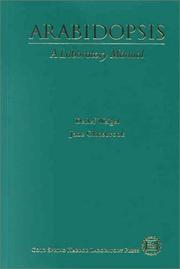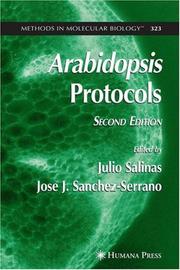| Listing 1 - 4 of 4 |
Sort by
|

ISBN: 0879695722 0879695730 9780879695736 9780879695729 Year: 2002 Publisher: Cold Spring Harbor : Cold Spring Harbor Laboratory Press [C.S.H.L.],
Abstract | Keywords | Export | Availability | Bookmark
 Loading...
Loading...Choose an application
- Reference Manager
- EndNote
- RefWorks (Direct export to RefWorks)
Arabidopsis --- Molecular aspects --- 582.683.2 --- 58.08 --- -Stenophragma --- Cruciferae --- Cruciferae. Stocks. Cresses. Water cress. Mustards. Radishes. Rape. Turnip. Wild cabbage. Rockets, Arabidopsis. Candytuft. Shepherd's purse. Woad. Brassicaceae --- Botanic techniques. Experimental methods. Equipment --- -Cruciferae. Stocks. Cresses. Water cress. Mustards. Radishes. Rape. Turnip. Wild cabbage. Rockets, Arabidopsis. Candytuft. Shepherd's purse. Woad. Brassicaceae --- 58.08 Botanic techniques. Experimental methods. Equipment --- 582.683.2 Cruciferae. Stocks. Cresses. Water cress. Mustards. Radishes. Rape. Turnip. Wild cabbage. Rockets, Arabidopsis. Candytuft. Shepherd's purse. Woad. Brassicaceae --- Stenophragma --- Arabidopsis - Molecular aspects
Book
ISBN: 0387940898 3540940898 1461276004 1461225981 Year: 1994 Publisher: New York (N.Y.) Springer
Abstract | Keywords | Export | Availability | Bookmark
 Loading...
Loading...Choose an application
- Reference Manager
- EndNote
- RefWorks (Direct export to RefWorks)
Phytomorphology. Phytoanatomy --- Dicotyledons --- Plant embryology and development --- Arabidopsis --- Morphology --- Atlases. --- Development --- -Arabidopsis --- -582.6/.9 --- Stenophragma --- Cruciferae --- -Atlases --- Dicotyledoneae --- DCO Dicotyledons --- Dicotyledonae --- development --- illustration atlas --- morphology --- 582.6/.9 Dicotyledoneae --- 582.6/.9 --- Development&delete& --- Atlases --- Morphology&delete& --- Arabidopsis - Morphology - Atlases. --- Arabidopsis - Development - Atlases. --- ARABIDOPSIS --- MORPHOLOGY --- PLANT DEVELOPMENT --- ROOTS --- FLOWERS --- POLLEN --- OVULES --- POLLINATION --- EMBRYOGENESIS --- PATHOGENS
Book
ISBN: 9401793735 9401793727 Year: 2014 Publisher: Dordrecht : Springer Netherlands : Imprint: Springer,
Abstract | Keywords | Export | Availability | Bookmark
 Loading...
Loading...Choose an application
- Reference Manager
- EndNote
- RefWorks (Direct export to RefWorks)
The functional characterization of a key enzyme in the phosphatidylinositol (PI) signaling pathway in the model plant Arabidopsis thaliana is the focus of this thesis. Moreover, a particular focus is the exploration of the biological functions of Arabidopsis phosphatidylinositol monophosphate 5-kinase 2 (PIP5K2), which catalyzes the synthesis of phosphatidylinositol (4,5) bisphosphate, the precursor of two important second messengers (inositol 1,4,5-trisphosphate and diacylglycerol). Employing molecular and genetic approaches, the author isolates and characterizes the expression pattern, physiological functions and underlying mechanism of Arabidopsis PIP5K2. In doing so, he reveals that PIP5K2 is involved in regulating lateral root formation and root gravity response through modulating auxin accumulation and polar auxin transport, and also plays a critical part in salt tolerance. These findings shed new light on the crosstalk between PI signaling and auxin response, both of which fulfill crucial regulatory roles in plant development.
Phosphoinositides --- Arabidopsis --- Research. --- Molecular aspects --- Stenophragma --- Cruciferae --- Phosphatidylinositides --- Phosphatidylinositol phosphates --- Phospholipids --- Inositol --- Biochemistry. --- Plant physiology. --- Plant anatomy. --- Plant Biochemistry. --- Plant Physiology. --- Plant Anatomy/Development. --- Botany --- Plant structure --- Plants --- Structural botany --- Vegetable anatomy --- Anatomy --- Physiology --- Biological chemistry --- Chemical composition of organisms --- Organisms --- Physiological chemistry --- Biology --- Chemistry --- Medical sciences --- Structure --- Composition --- Plant biochemistry. --- Plant development. --- Development of plants --- Plant development --- Developmental biology --- Growth (Plants) --- Phytochemistry --- Plant biochemistry --- Plant chemistry --- Biochemistry --- Phytochemicals --- Plant biochemical genetics --- Ontogeny

ISBN: 9781588293954 1588293955 9781597450034 1597450030 1280831944 9786610831944 Year: 2006 Publisher: Totowa, NJ : Humana Press : Imprint: Humana,
Abstract | Keywords | Export | Availability | Bookmark
 Loading...
Loading...Choose an application
- Reference Manager
- EndNote
- RefWorks (Direct export to RefWorks)
Emulating the much-praised first edition of Arabidopsis Protocols, leading scientists have generated an up-to-date work that reflects recent advances in plant biology, the completion of the Arabidopsis genome sequence-essential for studying plant function-and the development of whole systems approaches that allow global analysis of gene expression, as well as protein and metabolite dynamics. The authors have included nearly all techniques developed in Arabidopsis, others recently adapted from more traditional work in crop species, and the latest using Arabidopsis as a model system. Highlights include the most recent methods-transcriptomics, proteomics, and metabolomics-and their novel applications (phosphoproteomics, DNA microarray-based genotyping, high throughput metabolite profiling, and single-cell RNA). Traditional protocols from the agricultural sciences and others developed in crop species (grafting and chloroplast transformation) have been adapted to exploit the advantages of the Arabidopsis model. The protocols themselves follow the successful Methods in Molecular Biology™ series format, each offering step-by-step laboratory instructions, an introduction outlining the principles behind the technique, lists of the necessary equipment and reagents, and tips on troubleshooting and avoiding known pitfalls. Indispensable and highly practical, Arabidopsis Protocols, Second Edition offers both novice and experienced plant biologists cutting-edge tools to explore new scenarios and gain an understanding of how this complex, multicellular organism works, how it copes with a sessile life style, and how these strategies compare with those developed in other organisms.
Arabidopsis --- Plant Preparations --- Plant Components --- Laboratory manuals. --- Molecular aspects --- genetics --- Laboratory Manuals. --- genomes --- Génie génétique --- genetic engineering --- Molecular aspects. --- Arabidopsis -- Laboratory manuals. --- Arabidopsis -- Molecular aspects -- Laboratory manuals. --- Biological Products --- Anatomy --- Biology --- Publication Formats --- Brassicaceae --- Biological Science Disciplines --- Complex Mixtures --- Publication Characteristics --- Angiosperms --- Chemicals and Drugs --- Embryophyta --- Natural Science Disciplines --- Streptophyta --- Disciplines and Occupations --- Viridiplantae --- Plants --- Eukaryota --- Organisms --- Genetics --- Plant Structures --- Laboratory Manuals --- Botany --- Earth & Environmental Sciences --- Fungi & Algae --- Stenophragma --- Cruciferae --- Life sciences. --- Botany. --- Popular Science in Nature and Environment. --- Plant Sciences. --- Botanical science --- Phytobiology --- Phytography --- Phytology --- Plant biology --- Plant science --- Natural history --- Biosciences --- Sciences, Life --- Science --- Floristic botany
| Listing 1 - 4 of 4 |
Sort by
|

 Search
Search Feedback
Feedback About UniCat
About UniCat  Help
Help News
News